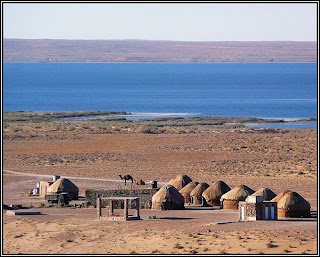 Ayaz Qala yurt camp (Uzbekistan)
Ayaz Qala yurt camp (Uzbekistan)photo courtesy flickr commons
 Kyrghiz family in front of their yurt near Issyk-Kul lake, Kirghizstan
Kyrghiz family in front of their yurt near Issyk-Kul lake, Kirghizstan photo courtesy wikicommons
Since timber was very hard to come by for the tribes, saplings were used and then covered with wool which was layered and watered into a felt. The word “felt” was originally a synonym for “nomads,” or the “felt people.” The felt, or animal fur covering the yurt, could be packed on in the winter for more warmth or removed during the summer for more ventilation.
In some cultures, the type of door on the yurt defined the owner’s status. For instance, Mongolian yurts use a thick wooden door, but the Turkic use rug flaps or brilliantly decorated cloth.
Originally, women were in charge of building and designing the yurt, which is much more complicated and impressive than it looks. It is circular in shape, which drives the wind around the structure as opposed to directly into or at it. The walls are made of lattice, and the roof beams, depending on the culture, can be extremely intricate and difficult to assemble. Oftentimes the building of the yurt was a community effort.
 An example of a modern yurt in the United States
An example of a modern yurt in the United States photo courtesy flickr creative commons
While the original yurt was taken very seriously and used as a means of primary survival, once the modern westerner got wind of the thing they, as per usual, began creating yurts that go beyond science fiction. Today, a yurt can cost from $10,000-$30,000, depending on how ridiculous you want to take it. There are yurts available which stand larger than the average house, with all the high-tech gadgetry, wood floors, multiple rooms and stories that define our current home architecture. Some of these yurts are stunning to look at after studying the ancient model.
 Cold kickin' it all up in tha yurt
Cold kickin' it all up in tha yurtphoto courtesy flickr creative commons
photo courtesy flickr commons


I'm so excited we featured the yurt! My husband and I plan on living in one some day.
ReplyDelete-Amber